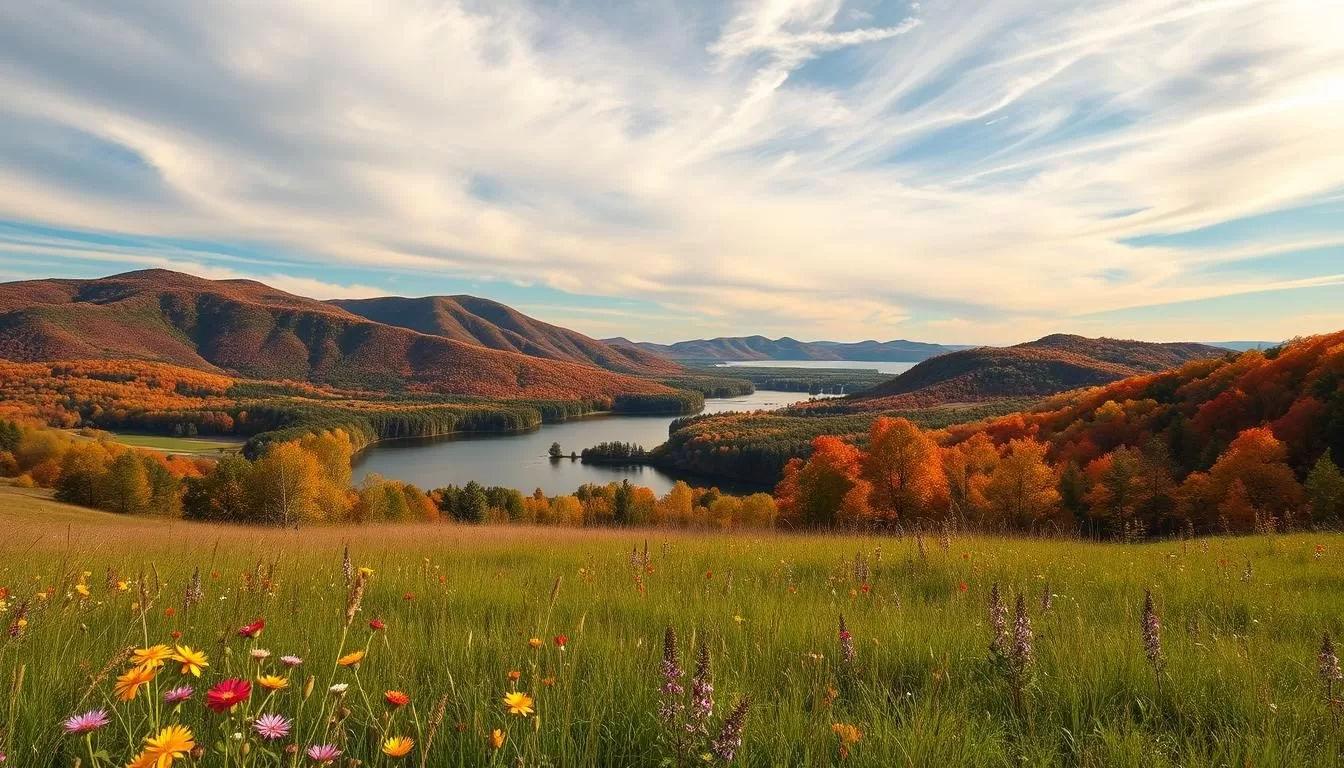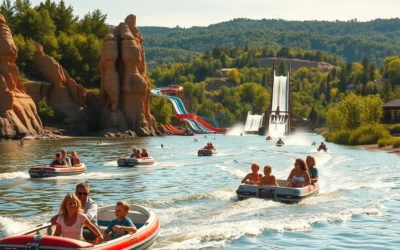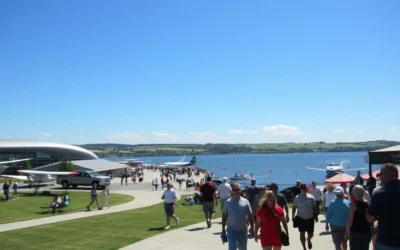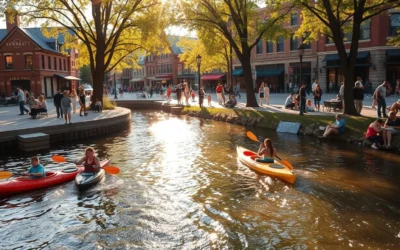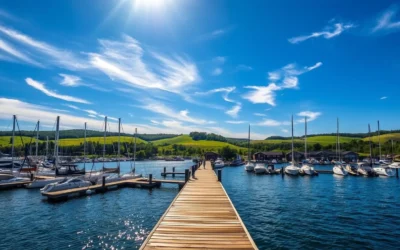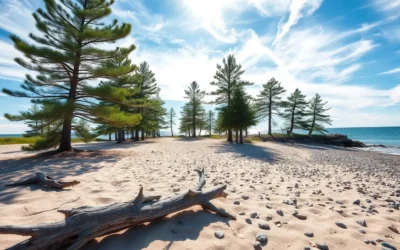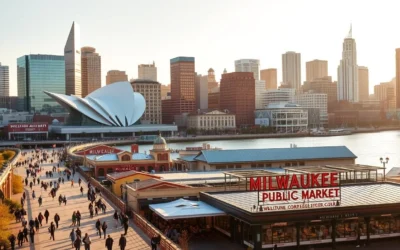✓ Accommodations ✓ Flights ✓ Rental Cars ✓ Tours & Activities
Planning a trip to Wisconsin can be a delightful experience, especially when you time it right.
With its diverse climate and seasonal attractions, the Badger State offers something unique throughout the year. Whether you’re looking for outdoor activities or cultural events, understanding the local weather patterns is key to maximizing your experience.
From the warmth of summer to the snowy landscapes of winter, Wisconsin transforms with the season, providing a distinct experience each time. This guide will help you navigate the best times to visit, ensuring your trip is filled with the activities and events that matter most to you.
Understanding Wisconsin’s Four Seasons
As you plan your trip to Wisconsin, understanding the state’s four seasons is crucial for a weather-savvy journey. Wisconsin’s climate is influenced by its geography, with distinct weather zones across the state.
Wisconsin’s Unique Climate Patterns
Wisconsin’s location between the Great Plains and the Great Lakes creates a dynamic weather pattern. The state’s climate is characterized by cold winters and warm summers, with transitional spring and fall seasons. Lake Michigan and Lake Superior play a significant role in shaping the state’s climate, bringing heavy snow to eastern Wisconsin in winter and cooler temperatures in summer to coastal areas.
The “lake effect” weather patterns have a significant impact on the state’s climate, with areas near the lakes experiencing different conditions than inland regions. For instance, Milwaukee temperatures are generally mild, except in January, when they dip into the teens.
How Geography Influences Weather Across the State
Wisconsin’s varied geography creates distinct weather zones across the state. The northern highlands, central plains, and southern lowlands each experience different conditions. Some key geographical features that influence the weather include:
- The northern highlands, which contribute to colder temperatures and more significant snowfall, making it an ideal place for winter sports like skiing and snowmobiling.
- The Mississippi River valley in western Wisconsin, which creates its own microclimate, often experiencing different weather patterns than the rest of the state.
- Central Wisconsin’s flat, open terrain, which allows weather systems to move quickly across the area, sometimes resulting in rapid weather changes.
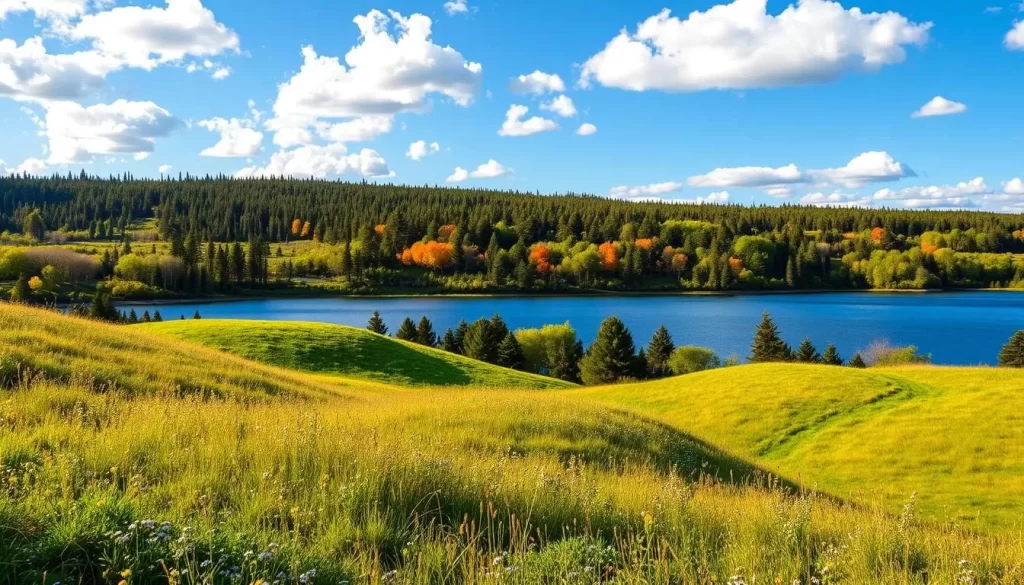
Understanding these geographical factors can help you prepare for the varying weather conditions across Wisconsin, whether you’re visiting in summer, spring, fall, or winter.
Summer in Wisconsin: June to August
The summer season in Wisconsin is characterized by warm weather, outdoor adventures, and cultural events. It’s a time when the state’s natural beauty is at its peak, and there’s always something happening, whether you’re interested in water activities, hiking, or simply enjoying the local festivals.
Temperature and Humidity Expectations
Summer in Wisconsin brings warm temperatures, with average highs often reaching the mid-80s to low 90s Fahrenheit (30-32°C). The humidity can be relatively high, making the heat feel more intense. However, the proximity to the Great Lakes helps moderate the climate, providing some relief from the heat.
Summer Festivals and Events
Wisconsin is renowned for its vibrant summer festivals, which celebrate everything from music and food to cultural heritage. You can enjoy outdoor concerts, visit local farmers’ markets, or participate in the numerous cultural events that take place across the state. Summer is also a great time for fun activities like boating, swimming, and fishing in Wisconsin’s abundant lakes and rivers.
Popular Summer Activities
Wisconsin’s diverse landscape offers a wide range of activities for outdoor enthusiasts. You can explore the state’s many state parks, go hiking on trails like the Ice Age Trail, or enjoy water sports on the numerous lakes. The summer months are also ideal for cycling, golfing, and wildlife viewing, making it a perfect season for people who love the outdoors.
Camping becomes extremely popular during the summer, with many state park campgrounds requiring reservations well in advance. The summer season is also a great time to explore Wisconsin’s agricultural tourism, including berry picking and farm tours. While it’s warm, it’s not typically associated with ice, but the memories of winter’s ice sports will be a distant memory as you enjoy the warmth.
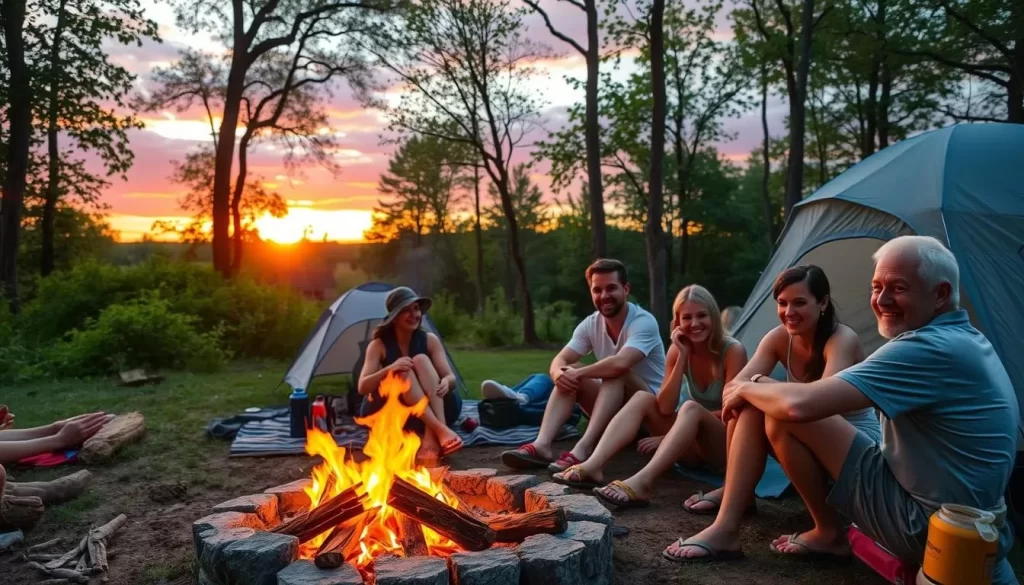
Fall in Wisconsin: September to November
Wisconsin’s fall season is a treat for the senses, with vibrant foliage and crisp air. As the summer warmth dissipates, the state transforms into a picturesque landscape, perfect for outdoor enthusiasts and those looking for a weekend getaway.
Fall Foliage and Temperature Patterns
During the fall season, Wisconsin’s temperatures gradually cool down, creating ideal conditions for enjoying the outdoors. Daytime temperatures range from the mid-50s to mid-60s Fahrenheit, while nighttime temperatures can dip into the 40s. The state’s diverse geography means that the peak foliage season varies across different regions.
The changing leaves create a kaleidoscope of colors, making it a great time for scenic drives, hiking, and other outdoor activities in areas like Door County and the Driftless Area.
Harvest Festivals and Autumn Events
Fall in Wisconsin is not just about the foliage; it’s also a season of harvest festivals and autumn events. Cities like Columbia host the Roots N Blues Festival, celebrating the local music scene, and Oktoberfest, honoring German-American culture with food, drinks, and fun. These events add to the festive atmosphere, making fall a great time to experience Wisconsin’s culture.
Visitors can enjoy a variety of activities, from live music to traditional German cuisine, making for a memorable weekend getaway.
Best Fall Outdoor Activities
Wisconsin offers a wide range of outdoor activities during the fall season. Some popular options include:
- Scenic drives along designated fall color routes, such as the Lake Superior Byway and Kettle Moraine Scenic Drive.
- Hiking and exploring the state’s extensive trail systems, with cooler temperatures and fewer insects.
- Mountain biking on single-track trails, like the CAMBA trails in Bayfield County.
- Kayaking or canoeing on Wisconsin’s rivers, offering unique perspectives on the fall foliage.
- Wildlife viewing, including birdwatching during migration and spotting deer during rutting season.
- Fall fishing for species like musky, walleye, and trout.
- Camping, with the rewards of smaller crowds and cooler sleeping temperatures.
- Horseback riding on designated equestrian trails in state forests.
- Hot air balloon rides for breathtaking aerial views of the fall landscape.
These activities make Wisconsin a great destination year round, but especially during the fall season.
Winter in Wisconsin: December to February
Wisconsin’s winter season is a magical time to experience the state’s festive atmosphere and outdoor activities. From December to February, the state transforms into a winter wonderland, offering a range of fun events and activities for all ages.
Snowfall Expectations and Temperature Range
Wisconsin’s winter months are characterized by cold temperatures and significant snowfall. December’s average high temperature is 33.1°F, while January’s average high is 28°F, and February’s is 32.5°F. The average low temperatures range from 19.4°F in December to 13.4°F in January and 18.3°F in February.
Winter Sports and Activities
Milwaukee winters are cold, but for the people of this Midwestern outpost, it’s time to get outdoors and enjoy winter sports like cross-country skiing and snowshoeing, dog sledding, downhill skiing, and snowboarding, ice fishing, snow tubing, and snowmobiling. Don’t forget to warm up with hot chocolate afterward. You can also explore some of the city’s great James Beard-awarded restaurants.
Holiday Events and Festivals
Wisconsin embraces the holiday season with festive events that transform communities into winter wonderlands despite the cold temperatures. Some of the top events include:
- Milwaukee’s Holiday Lights Festival, featuring animated displays in three parks connected by a free shuttle service.
- Christmas markets inspired by European traditions, offering handcrafted gifts, seasonal foods, and festive atmospheres.
- Historic home tours during the holiday season, showcasing Wisconsin’s architectural heritage with period decorations and special events.
- New Year’s Eve celebrations, ranging from family-friendly early evening events to midnight countdowns.
- Winter carnivals and ice festivals, celebrating the season with ice sculptures, snow thrones, winter sports competitions, and warming bonfires.

Other exciting events include the Apostle Islands Sled Dog Race, eagle watching events along the Wisconsin, Mississippi, and Fox Rivers, and candlelight ski, snowshoe, and hiking events in state parks. You can also enjoy indoor events like the Milwaukee Symphony Orchestra’s holiday concerts, providing cultural experiences in climate-controlled comfort during the coldest months.
Spring in Wisconsin: March to May
Spring in Wisconsin is a season of renewal, bringing with it a plethora of activities and breathtaking landscapes. As the snow melts away, the state transforms into a vibrant paradise for outdoor enthusiasts and nature lovers alike.
Spring Weather Patterns and Considerations
During spring, Wisconsin’s weather gradually warms up. March temperatures range from highs of 42.6°F to lows of 27.3°F, while April sees highs of 53.9°F and lows of 36.4°F. By May, the temperatures further rise to highs of 66°F and lows of 46.2°F. It’s essential to be prepared for variable weather conditions, including potential late-season snow and rain showers.
Spring Events and Attractions
Wisconsin hosts various spring events and attractions that cater to different interests. Some of the highlights include:
- Spring fishing, with species like walleye, northern pike, and trout becoming more active.
- Festivals celebrating the arrival of spring, often featuring local produce, crafts, and live music.
- Guided tours and workshops focused on spring activities like birdwatching and gardening.
Outdoor Activities in Spring
Spring is an excellent time to engage in various outdoor activities in Wisconsin. Some popular pursuits include:
- Hiking through state parks and natural areas, where trails come alive with spring wildflowers.
- Fishing in the state’s numerous lakes and rivers, with the annual spawning runs creating excellent fishing opportunities.
- Waterfall watching at locations like Copper Falls State Park, Amnicon Falls, and Big Manitou Falls.
- Birdwatching during spring migration, with hotspots like Horicon Marsh and the Mississippi River flyway.
- Paddling on rivers that swell with spring runoff, offering exciting whitewater and gentle flows.
- Cycling on Wisconsin’s extensive trail network, such as the Elroy-Sparta, Badger, and Great River State Trails.
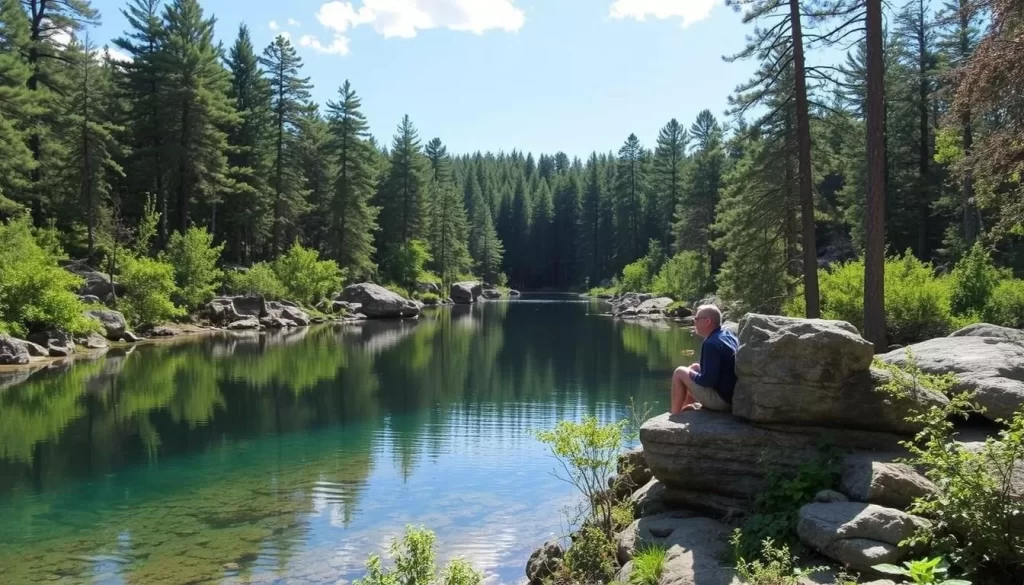
Whether you’re interested in exploring the great outdoors or simply enjoying the local culture, Wisconsin’s spring season has something for everyone. With its diverse range of activities and attractions, it’s an ideal time to visit and experience all that the state has to offer.
Wisconsin, United States: Best Months for a Weather-Savvy Trip
To make the most of your trip to Wisconsin, understanding the state’s seasonal variations is key. Wisconsin’s climate varies significantly throughout the year, offering a range of experiences for visitors.
Peak Season vs. Off-Peak Benefits
Understanding the benefits of visiting during peak and off-peak seasons can help you plan a more enjoyable trip. Peak season, typically during summer, offers warm weather and a wide range of outdoor activities. However, it’s also the busiest time, with larger crowds and potentially higher prices for accommodations.
In contrast, the off-peak seasons, such as spring and autumn, can offer a more relaxed atmosphere and lower prices. For instance, May-June and September-October are great times to enjoy mild weather and smaller crowds, making them ideal for those seeking a more personal experience with local producers and attractions.
Weather-Based Recommendations by Interest
Wisconsin caters to various interests across different times of the year. Here are some recommendations based on your interests:
- For hiking and backpacking, September and early October are ideal due to comfortable temperatures and spectacular fall colors.
- Water sports enthusiasts will enjoy July and August for warm water temperatures, with Lake Michigan beaches reaching comfortable swimming temperatures by mid-July.
- Fishing opportunities exist year-round, but species-specific timing matters: May-June for walleye, July-August for bass, September-October for musky, and January-March for ice fishing.
- The Apostle Islands are best visited in July-August for kayaking or in February-March for the spectacular ice caves.
- Fall color enthusiasts should plan trips from late September in northern Wisconsin to mid-October in southern areas.
- Winter sports enthusiasts will find reliable snow conditions from January through early March.
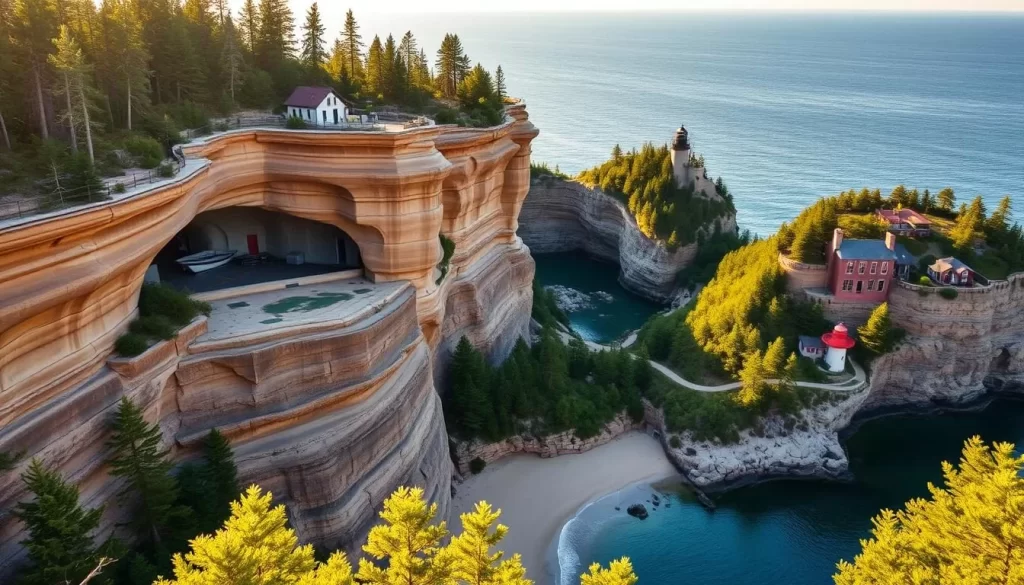
Planning Your Trip: Weather-Based Travel Tips
To make the most of your Wisconsin adventure, it’s crucial to consider the time of year and how the weather might impact your plans. Wisconsin’s climate varies significantly across seasons, making preparation key to a smooth trip.
What to Pack for Each Season
Packing appropriately for your visit to Wisconsin depends on the season. For winter trips, from December to February, warm clothing, including a heavy coat, gloves, and hat, is essential due to potential snow and cold temperatures. In contrast, summer visits, from June to August, require lighter clothing, though evenings can still be cool, especially near the Apostle Islands. During spring and fall, layers are advisable as temperatures can fluctuate significantly.
Transportation Considerations by Season
When traveling to Wisconsin, consider the weather when planning your transportation. For winter travel, renting a vehicle with all-wheel or four-wheel drive is advisable, especially if you plan to explore rural areas. In summer, while road trips are generally straightforward, traffic can be heavy around popular destinations like Wisconsin Dells and Door County on weekends. Public transportation is limited outside major city centers, making rental cars essential for exploring the state’s rural landscapes and state parks.
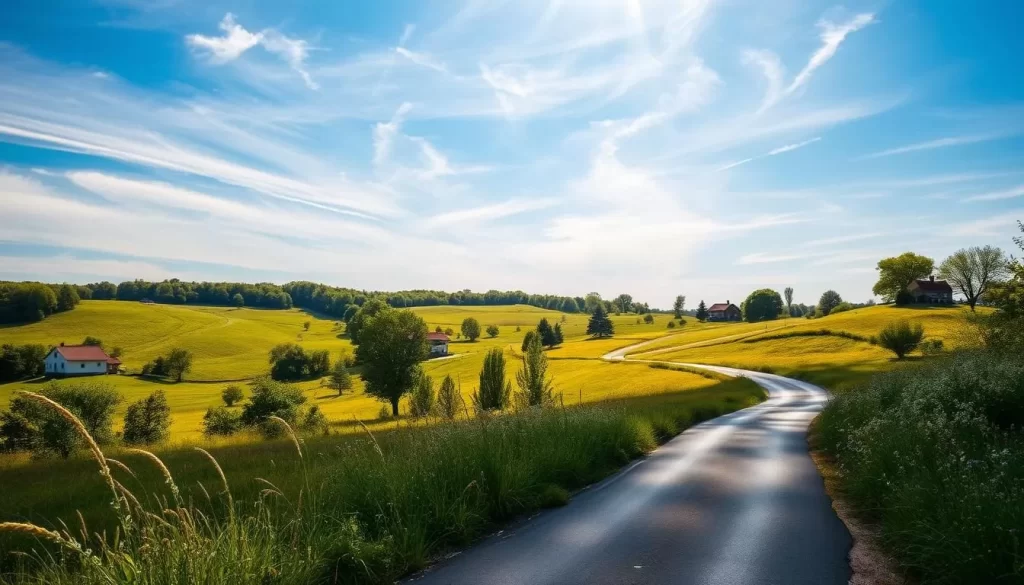
Conclusion
Wisconsin’s changing seasons bring a kaleidoscope of experiences, making it a fantastic destination for travelers. The state’s year-round appeal means that the best time to visit largely depends on your personal interests and weather preferences. Summer offers warm temperatures ideal for exploring lakes and attending festivals, while fall provides a balance of comfortable temperatures and spectacular scenery.
Winter transforms Wisconsin into a snow-covered playground for enthusiasts of cold-weather activities like ice fishing on the Apostle Islands. In contrast, spring brings renewal with wildflowers, waterfalls, and migrating birds, offering good value and fewer crowds. The question of when to visit ultimately comes down to what experiences you value most.
Regardless of when you choose to visit, Wisconsin offers both indoor and outdoor options in every season, allowing you to adapt to conditions and have a memorable trip. Researching local events and festivals can help determine your ideal travel dates. To truly experience Wisconsin’s beauty, make time to connect with locals who can guide you to hidden gems and authentic experiences.
By understanding the state’s weather patterns and seasonal activities, you can plan a trip that suits your preferences, making the most of your time in this beautiful state. Whether you’re looking for a great time or a specific experience, Wisconsin has something to offer, inviting you to return and explore its many faces throughout the year.
The above is subject to change.
Check back often to TRAVEL.COM for the latest travel tips and deals.
